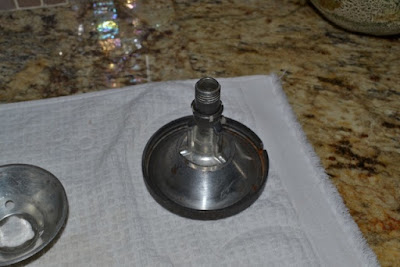Not only did I buy a cream separator, but I bought a vintage cream separator. And, not only did I buy a vintage cream separator, I bought a hand crank vintage cream separator. Am I a glutton for punishment or what?
There were several to choose from, as the shop owner had bought someone's collection. I had chosen a particular one because the crank worked smoothly as opposed to another one whose crank wouldn't turn. But, Tom went with me to pick it up and asked to look at the "cones", which were rusted. I thought, "big deal, who cares if the cones are rusted?" because I didn't know what the cones were for. Quite frankly, I hadn't a clue how a cream separator worked.
Nobody told me that the innards of a cream separator look like this! And, nobody told me that those cones are actually what separates the cream. I thought they were just for weight to make the thingy spin. *color me pink*
Tom talked me into getting this Viking model, whose crank wouldn't turn, but the cones weren't rusted. He assured me that he could fix the crank. So we came home with the Viking, and indeed, he fixed the crank right up. And I proceeded to clean all the little parts, all 21 of them.
So, for those as unfamiliar with a cream separator as I am, this is the part that all those cones fit onto and this is what spins when the crank is turned.
These are the cones. They are keyed so that they fit on correctly. We still don't know if they go on in a certain order, so I was very careful to put them back on in the order that they came off. I guess I'll find out if this is right when I try to use it.
After I scrubbed all the years of crud off of the pieces, I fitted the cones back on the cone holder (I'm sure these have more technical names, but I don't have a clue).
All of them on.
Then the cover fits down over the cones.
This ring screws down over the top to hold it all together.
No, it does not emit bubbles. My camera flash caused a reflection off the glass tiles.
Then the cone spinner thing fits down in the separator base.
All nestled in and ready to spin.
Then two trays with spouts fit on. This is a magical machine and apparently, while cranking and spinning, cream comes out of one spout and the skimmed milk out the other.
The bowl sits on top of the spout things.
This gadget...
fits down in this hole in the center of the bowl/milk receptacle.
See how it has holes in it? Those holes line up with the holes in the gadget. To control the flow of milk going into the spinner, the gadget is turned so that milk flows through the holes.
This is Tinkerbell's bell (see, I told you it was magic). It rings if you aren't cranking fast enough. "Ring, ring, ring, crank faster, crank faster!"
Gadget in hole.
Assembled and awaiting milk and cranker.
I can't wait to try it. But, I am not looking forward to cleaning it again and again.






































